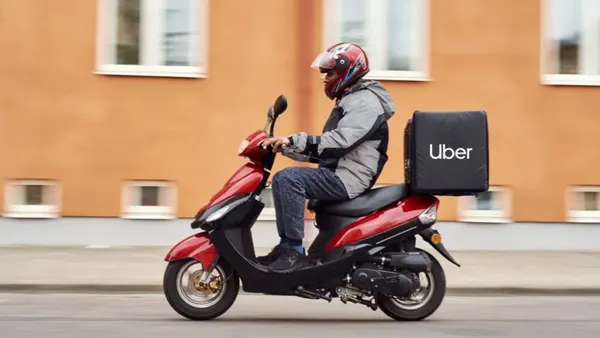Dive Brief:
- Two restaurants sued Grubhub on Monday for adding them to its online platform without permission. The plaintiffs are proposing a class-action lawsuit on behalf of over 150,000 unaffiliated restaurants that were added to the platform since 2019, according to a court filing. Grubhub said it does not comment on pending litigation.
- The lawsuit also claims that Grubhub told its drivers to act as if they were a diner picking up an order at a non-partner restaurant, making a distinction in the driver’s app between partnered restaurants and non-partnered restaurants by highlighting unaffiliated businesses in purple.
- Following a loss of market share and slowing growth, Grubhub turned toward the strategy of adding non-partnered restaurants to help recapture and retain more customers. By the end of 2019, Grubhub grew its platform to 300,000 restaurants, of which 150,000 were non-partnered. The lawsuit claims the company grew its revenue and stock price at the expense of these unaffiliated restaurants.
Dive Insight:
Food delivery aggregators have been adding non-partnered restaurants to their platforms for years, but not without heavy criticism.. DoorDash and Postmates have been in hot water in the past over the practice, and In-N-Out sued DoorDash in 2015 because of it. Restaurants argue that these listings often contain incorrect menus and generate the brunt of customer complaints for orders the owners weren’t even aware of. California passed a law that will ban the practice starting Jan. 1, which Grubhub said it supports.
Grubhub did not disclose how many non-partnered restaurants are on its platform when it released its Q3 2020 earnings Wednesday. The company has about 245,000 partnered restaurants in its system, an uptick of almost 20,000 from late July.
Grubhub originally stayed away from non-partner listings, preferring to only list partnered restaurants, and believed that the controversial strategy often led to a bad experience for customers, drivers and restaurants. Non-partnered restaurant listings can also cost customers more, since they would take the brunt of the delivery fees.
"Some companies built their businesses by listing non-partner restaurants on their platforms and delivering food without an agreement so they could expand their restaurant supply, but this strategy fails to drive long-term value in the food delivery industry,” Grubhub said previously.
However, Grubhub also doubled its restaurant count in Q4 2019 to 300,000 by adding 150,000 non-partnered restaurants and 15,000 partnered brands, according to a letter to shareholders. It said the growth was a major milestone for the brand and came well ahead of its goal of doubling its restaurant count by the end of 2020.
The company has said in the past that it would remove restaurants from its platform as soon as the restaurant informs Grubhub they do not want to be listed. However, plaintiff Lynn Scott, owner of Antonia’s restaurant in North Carolina, said she declined to become a Grubhub partner and claimed that Grubhub listed her restaurant on its website anyway.
The lawsuit says that listing restaurants without permission leads to business being taken away from an existing takeout or delivery service, including business through an authorized third-party partner. The suit also claims the practice can cost the restaurant future demand, claiming that once Grubhub retains a customer it encourages that person to order from a partnered restaurant instead, posts non-partner menus with inflated prices, and creates landing pages for unaffiliated restaurants saying that those restaurants are not taking orders and suggests a partner restaurant instead.
Even though Grubhub knows the experience is bad for customers, it still continues to do so, according to the lawsuit. If a customer had negative feedback, Grubhub doesn’t share those comments with the restaurant, which is often unable to communicate with that customer, the lawsuit claims.
If this case were to become a class-action lawsuit, it could have implications not only for Grubhub, but also for other delivery providers using this strategy. While food delivery platforms would likely have to remove unaffiliated restaurants, not using the practice would create a more level playing field among food delivery companies. They would be able to focus on building stronger relationships with restaurants, which could lead to more revenue from marketing and other services offered directly through these partnerships. Grubhub, for example, rolled out its Perks program last year to offer customers a way to redeem loyalty rewards with partnered restaurants, which helps with customer retention for both parties.













